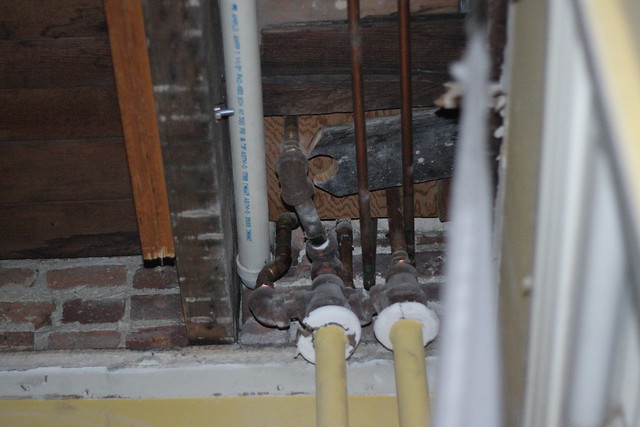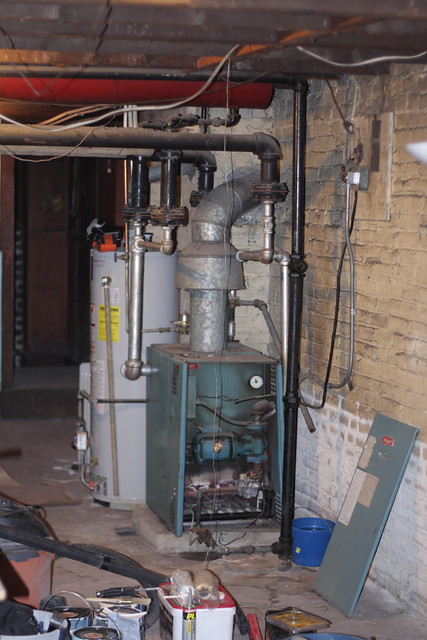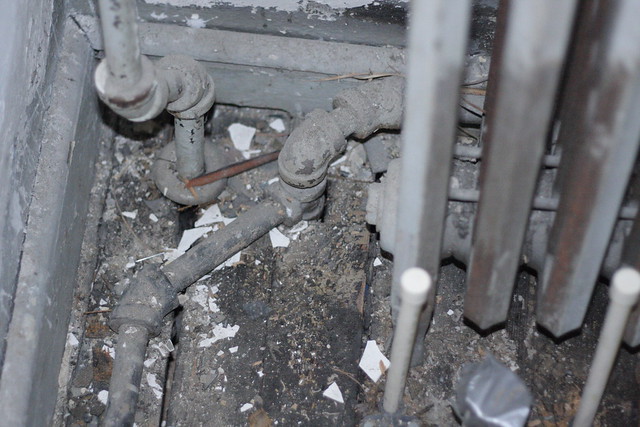To help us learn to look at this house and see beyond peeling paint and warped floorboards, to understand the language of the creaks and cracks and hisses and stains, we began a flurry of consulting with professionals, amateurs, neighbors, colleagues, friends, and family far and near.
In this early period, during the first two weeks of home ownership, T&H weren't even certain, yet, if they wanted to do any of the rehabilitation work themselves or hire it out completely. With every visit of a potential contractor, our knowledge and understanding increased. Neighbors shed light on the shared idiosyncrasies of our houses and utility systems. Information gathered was tested against the intuition of our fathers and aunts and uncles.
The time to make some fundamental decisions was quickly approaching, but our confidence in our understanding of What Needs To Be Done was still shaky. And so it came to be that we engaged the services of a very kind, encouraging, and helpful home inspector named Keith.
We had received proposals of sorts from contractors saying they would test the plumbing and patch any small areas that need patching or leaks that needed sealing. Keith showed us all of the reasons why none of the plumbing could be saved.
On the electrical side of things, we waded in worries, inspired by neighbors relating stories of knob and tube wiring, but Keith tested and confirmed that even the electrical to our weirdest switches passed code.
One of the most exciting parts of the home inspection occured when we turned on the heating system. This system was a huge unknown in our world of cost estimating. The system is driven by a forced hot water boiler, of the cast iron variety, 39 years old. The boiler is located in the basement and is connected to cast iron radiators on upper floors, and to one baseboard-style heating loop on the second floor. From contractors we had heard numbers in every ballpark, but always the same tagline: "We won't know for sure how much it'll cost until we get in there and start working." But Keith turned that boiler on and nothing exploded! No radiators leaked! Everything got hot!
We learned much from Keith, but the major positive take away from that day was: At least the boiler's ok! Let's not mess with the heating system at all.
Well, we're going to mess with it.
We spoke to a few plumbers a couple months ago, and the majority of them shied away from working on these old heating systems. Scary strings of words like, "could be a couple hundred, could be two grand, or... (trails off, eyes look to the distance)," and, "every union you crack is an opportunity for disaster," and, "but generally I dislike working with heating pipes," and, "I wouldn't touch the system, myself," had us trepidatious for a while. But subsequently we've spoken with plumbers who like working with heating pipes, and we've read up on others' experiences, and we continue to seek advice. I'm raring to have a crack at these radiators now.
Currently, we are working on finishing all of the bathrooms. Two of the bathrooms I'm working on have heating fixtures that need messing with. Here is a very schematic drawing of those heating fixtures as they relate to eachother and the boiler:
 | ||
| pink zones = bathroom tile zones blue lines = galvanized or brass pipe orange lines = copper pipe everything else not shown for clarity (click to enlarge) |
Each bathroom's heating fixture has unique needs and challenges. Let's start with the third floor. Here's a close-up:
 |
| front view |
 |
| back view |
Here is a photo collage of the heating fixture in the bathroom:
 |
| don't forget to click to enlarge! |
On the second floor, the "radiator" is a a baseboard heating system that was hidden underneath a long vanity.
A closer look at the connections below the floor:
 |
| from above |
 |
| from below |
We know that we must drain the system below the elevation of the unions we will be opening. We know that the unions themselves are pretty straightforward.
What we don't know is this:
What's the best way to go about removing that pipe on the third floor?
Once everything has been removed, what's the best way to cap the pipes to be able to use the rest of the heating system while we finish the bathrooms? (Is that a bad idea in the first place?)
What are the tips and tricks to re-filling the system?
What would you do?






it looks like you're going to re-tile...you might look into installing in-floor radiant instead of wall radiators. it's incredibly efficient, and feels good on your feet. i think you can even buy plywood subfloor with the pipes integrated, so it doesn't add thickness to the floor assembly.
ReplyDeletegood luck!
aaron
Indeed, new tile!
ReplyDeleteSo, those in-floor radiant systems are totally separate systems, though, right? I mean, often times it's like some kind of anti-freeze type chemical that goes through the pipes, right?... but I don't know much about them. I've only researched a little bit.
Basically, we do not have a large budget for this. Do you think there's a way we could do it with a low cost? Otherwise I think we have to stick with the heating system we got.
Nice PEX, dude, totally radiant:
ReplyDeletehere a good url--it has two good graphics of your boiler system--
http://www.thisoldhouse.com/toh/article/0,,1548320-3,00.html
looks like it is what you may want throughout the house.
PEX --straight dope, on tools needed, connections. etc. -- http://www.pexinfo.com/
Commercial sight with more ideas--see contractor -- http://www.zurnpex.com/
DYI sight has practical info, including mentioning that you must have a PEX designed cutting tool and it ain't cheap (will research) -- http://www.doityourself.com/stry/install-PEX
Video on cutting and fitting PEX -- simple but thorough --http://www.doityourself.com/video/How-To-Connect-PEX-Pipe-165211741
Home Depot has PEX Supplies -- http://www.homedepot.com/webapp/wcs/stores/servlet/Search?keyword=pex&langId=-1&storeId=10051&catalogId=10053
25 USD for 100 ft
it looks like you can use some of these systems with your boiler, but you need to check with a plumber for compatibility with your manifold.
ReplyDeletehttp://www.warmboard.com/technical-information/faq/
i'm not sure about cost, but it seems like since your boiler is already up and running, the end cost may not be much different from re=installing your radiators [esp if you need to buy some new ones]. anyway, just an idea
aaron
I would like to refer you to two plumbers I know, Mario and Luigi. They are very skilled with handling pipes as well as any pesky koopas you might run into. I found them useful because not only did they fix up the plumbing in our bathroom but the number of gold coins they found in our pipes ended up paying for all the labor so we just had to cover parts. They are good guys.
ReplyDeleteAgreed the manifold was designed for a different system; however since the 1" +/_ pipe is already necked down to 1/2" copper, and it is working, it's a good chance you can go with the 1/2" PEX, especially on the 3rd floor. (system reduces down in stages as it leaves the boiler.) Mario and Luigi are taking advantage of the SUPER deals on jaunts to Tahiti and Bali, so I'll give my Boston plumber a shout.
ReplyDelete